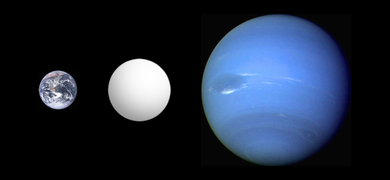
Back Superaarde Afrikaans Supertierra AN أرض هائلة Arabic Свръхземя Bulgarian Superzemlja BS Superterra Catalan Superzemě Czech Superjordkloder Danish Supererde German Υπεργαία Greek

A Super-Earth is a type of exoplanet with a mass higher than Earth's, but substantially below those of the Solar System's ice giants, Uranus and Neptune, which are 14.5 and 17 times Earth's, respectively.[1] The term "super-Earth" refers only to the mass of the planet, and so does not imply anything about the surface conditions or habitability. The alternative term "gas dwarfs" may be more accurate for those at the higher end of the mass scale, although "mini-Neptunes" is a more common term.
- ^ Valencia, V.; Sasselov, D. D.; O'Connell, R. J. (2007). "Radius and structure models of the first super-earth planet". The Astrophysical Journal. 656 (1): 545–551. arXiv:astro-ph/0610122. Bibcode:2007ApJ...656..545V. doi:10.1086/509800. S2CID 17656317.
© MMXXIII Rich X Search. We shall prevail. All rights reserved. Rich X Search